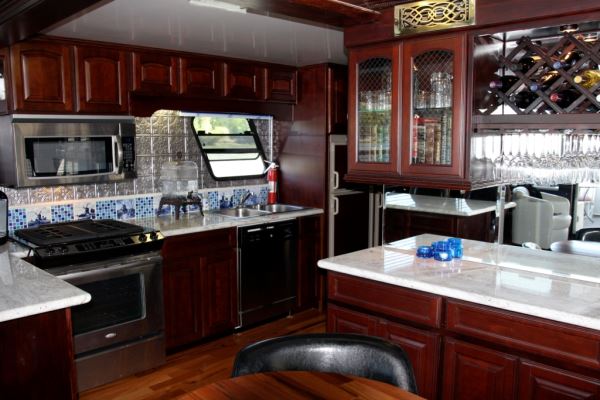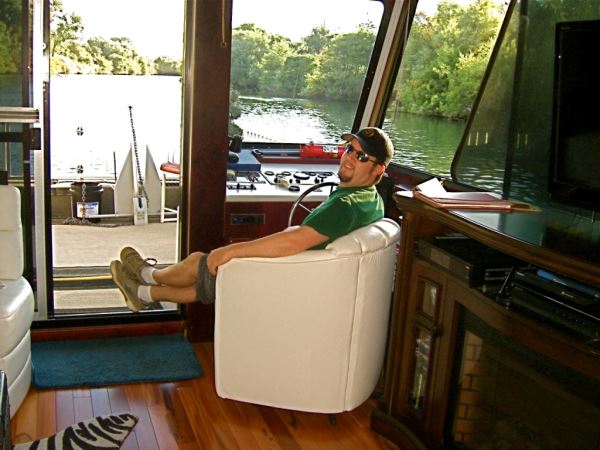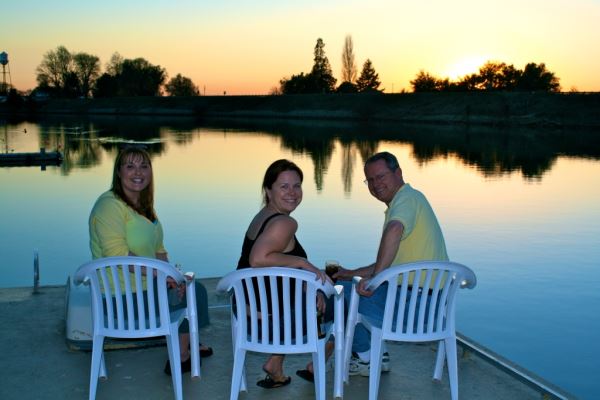
Perhaps as early as my fourth grade reading of Huckleberry Finn I’ve been drawn to the banks and currents of a river’s flow, the shoreline of greenery, the musky smell of tidewaters and soggy banks, and the vast array of river craft and people seeking pleasure. The rivers are ever-changing in movement and in life on the move.
After a career in the army and its endless remote postings, I was able to settle as a teacher in Reno, Nev. It was on a spring vacation with my girlfriend in 1999 that I first rented a small houseboat for a week from Herman and Helen’s on the Sacramento/San Juaquine Delta. On that first vacation and not 30 minutes out from the marina—as we cruised along at six miles an hour—we felt miles away and a timeless separation from the cares and woes of work. Days of easy bobbing along the currents of riverways and sloughs of the Delta, through drawbridge openings and mixing it up with fishermen in rustic cafes and bait-shops, along with the gorgeous sunsets over distant hills, I was hooked. Five years later, renting another 30-footer for a spring break with my kids and their spouses confirmed this as a lifestyle I must pursue.
 So five years later, in 2009, I bought a 56-foot, 1998 Stargazer made by Fun Country from a rental service on Shasta Lake in northern California. It seemed like a good deal, but as they say, buyer beware! I was a beginner as I learned by trying to retrofit it for the Sacramento River Delta where I wished to birth it, five miles from Old Town Sacramento.
So five years later, in 2009, I bought a 56-foot, 1998 Stargazer made by Fun Country from a rental service on Shasta Lake in northern California. It seemed like a good deal, but as they say, buyer beware! I was a beginner as I learned by trying to retrofit it for the Sacramento River Delta where I wished to birth it, five miles from Old Town Sacramento.
The first expensive retrofit that I needed was having shore power hookups made. Seems batteries and a generator are just fine for a lake rental, but I was ultimately looking to be a liveaboard. I also needed to replace the 50-gallon water tank with a 150-gallon tank as the Sacramento River is nowhere as clean as Shasta Lake for using ambient water for washing and bathing. Also, a rental craft on a lake can easily get by with just one engine, as long as you’re a cell phone call away from getting help. On the river, a second engine would aid immensely in navigating, but a greater comfort is to have towing insurance. I’ve accepted the one engine as a challenge in planning my cruising where tides, currents and winds, along with possible unscheduled mooring locations, must be factored. Also, having two large anchors for emergencies is essential.
 Those first few months were dismal. Gray skies and rain beating on the outside of the boat were made no less comfortable by the dry clouds of sawdust which enveloped me as I studded out the side walls and covered over all the luan siding with cherry. Endless loads of cherry siding were carried down the dock and an equal number of loads of demolished couches, dinettes, old vanities and beds were carried up for trailering off to the dump.
Those first few months were dismal. Gray skies and rain beating on the outside of the boat were made no less comfortable by the dry clouds of sawdust which enveloped me as I studded out the side walls and covered over all the luan siding with cherry. Endless loads of cherry siding were carried down the dock and an equal number of loads of demolished couches, dinettes, old vanities and beds were carried up for trailering off to the dump.
It was beneficial to be renovating close to a city for proximity to hardwood dealers, flooring suppliers and hardware stores. However, when you get to be on a first-name basis with your hardwood dealer, you know your retirement income-stream is threatened. Working from one electrical cord of shore-provided 120 current, I had three outlets—one for light, one for a power tool and an extra for a heater or my toaster oven.
 The main salon was stained in dark mahogany. Later when the sun came out, it occurred to me why so many boats are outfitted with light interior wood. It’s hard to see in a dark interior after coming in from the blinding light of the outer decks and sun on the water. But I love the rich gentleman’s club atmosphere of my salon. The original light oak galley cupboards were re-surfaced with cherry and new cherry doors. I built out the beams with moldings to give a coffered ceiling look. An extra beam was also installed for symmetry and was wired for the possible later addition of a decorative chandelier.
The main salon was stained in dark mahogany. Later when the sun came out, it occurred to me why so many boats are outfitted with light interior wood. It’s hard to see in a dark interior after coming in from the blinding light of the outer decks and sun on the water. But I love the rich gentleman’s club atmosphere of my salon. The original light oak galley cupboards were re-surfaced with cherry and new cherry doors. I built out the beams with moldings to give a coffered ceiling look. An extra beam was also installed for symmetry and was wired for the possible later addition of a decorative chandelier.
My father helped me build the hutch or dry waiter with the beveled glass cupboard doors. He also made the dinette table out of leftover flooring. The stateroom wardrobe door frames were kept, but a lattice was installed with back-lighting, which casts a nice checkered pattern about the room—a design feature remembered from my 1990 stay at the Manila Hilton—MacArthur’s HQ in the Philippines. Besides the electrical work, the only other upgrades hired out were the installation of the new Brazilian tiger-wood floors and the installation of the “White River” granite counter-tops.
 As a rental, the boat was designed to sleep up to 12 people. As a boat owner, the idea of so many guests seems a bit trying, so I set out to reduce the number of beds, knowing air mattresses on the upper deck are always a possibility. After contacting the engineers at Fun Country, I removed the wall separating the rear upper bunk from the hallway, installed a beam and built an angled bed—much easier to make than a bunk. This eliminated the lower bunk, but much of that storage space was retained using lift-tubes on the bed platform. The other lower bunk was replaced with carpeting, shelving and cupboards to make a tidy little study. Unstained cherry was used in each of the staterooms, which is already taking on a rich luster of age. Each of the heads were upgraded with new vanities, top-of-the-line toilets, painted and re-tiled. Only the original shower and refinished medicine cabinets remain.
As a rental, the boat was designed to sleep up to 12 people. As a boat owner, the idea of so many guests seems a bit trying, so I set out to reduce the number of beds, knowing air mattresses on the upper deck are always a possibility. After contacting the engineers at Fun Country, I removed the wall separating the rear upper bunk from the hallway, installed a beam and built an angled bed—much easier to make than a bunk. This eliminated the lower bunk, but much of that storage space was retained using lift-tubes on the bed platform. The other lower bunk was replaced with carpeting, shelving and cupboards to make a tidy little study. Unstained cherry was used in each of the staterooms, which is already taking on a rich luster of age. Each of the heads were upgraded with new vanities, top-of-the-line toilets, painted and re-tiled. Only the original shower and refinished medicine cabinets remain.
 After two years of renovations, most of the work was complete and life aboard was n-i-c-e. I had planned to teach a few more years, but it got harder and harder to drive back over the mountains to Reno after such peaceful weekends on the river. A few calculations on living expenses and the decision was made to retire in June of 2011. As a liveaboard, I’ve given up nothing and am embracing my new life of yoga, book clubs, photo journaling, tango dances, bike riding along the levees, travel, fun with family and mixing it up with my marina neighbors. As I’ve discovered, boating life often presses you to make choices about how to use your limited spaces. (I’m sure sail-boaters scoff at this notion coming from a “houseboater.”) But a nearby storage unit has helped me ease into what to let go of and what to postpone in down-sizing.
After two years of renovations, most of the work was complete and life aboard was n-i-c-e. I had planned to teach a few more years, but it got harder and harder to drive back over the mountains to Reno after such peaceful weekends on the river. A few calculations on living expenses and the decision was made to retire in June of 2011. As a liveaboard, I’ve given up nothing and am embracing my new life of yoga, book clubs, photo journaling, tango dances, bike riding along the levees, travel, fun with family and mixing it up with my marina neighbors. As I’ve discovered, boating life often presses you to make choices about how to use your limited spaces. (I’m sure sail-boaters scoff at this notion coming from a “houseboater.”) But a nearby storage unit has helped me ease into what to let go of and what to postpone in down-sizing.
 Now that the inside is complete, this will be the year for outside deck upgrades. I’ve recently replaced the all-weather lower-deck carpeting with Flexi-teak, installed a larger bimini on the upper deck, and will soon have a davit and support frame installed to store my new 13-foot Boston Whaler on an extension of the upper aft-deck. I also have plans for 12-volt LED lighting to go around the upper deck’s rim for night running. I’m running out of ideas; I guess I better get back to the boat magazines in the book stores. But in the final analysis, owning a houseboat is like having training wheels for even greater challenges—like sailing the off-shore big blue, or cruising the Great Loop in a trawler.
Now that the inside is complete, this will be the year for outside deck upgrades. I’ve recently replaced the all-weather lower-deck carpeting with Flexi-teak, installed a larger bimini on the upper deck, and will soon have a davit and support frame installed to store my new 13-foot Boston Whaler on an extension of the upper aft-deck. I also have plans for 12-volt LED lighting to go around the upper deck’s rim for night running. I’m running out of ideas; I guess I better get back to the boat magazines in the book stores. But in the final analysis, owning a houseboat is like having training wheels for even greater challenges—like sailing the off-shore big blue, or cruising the Great Loop in a trawler.